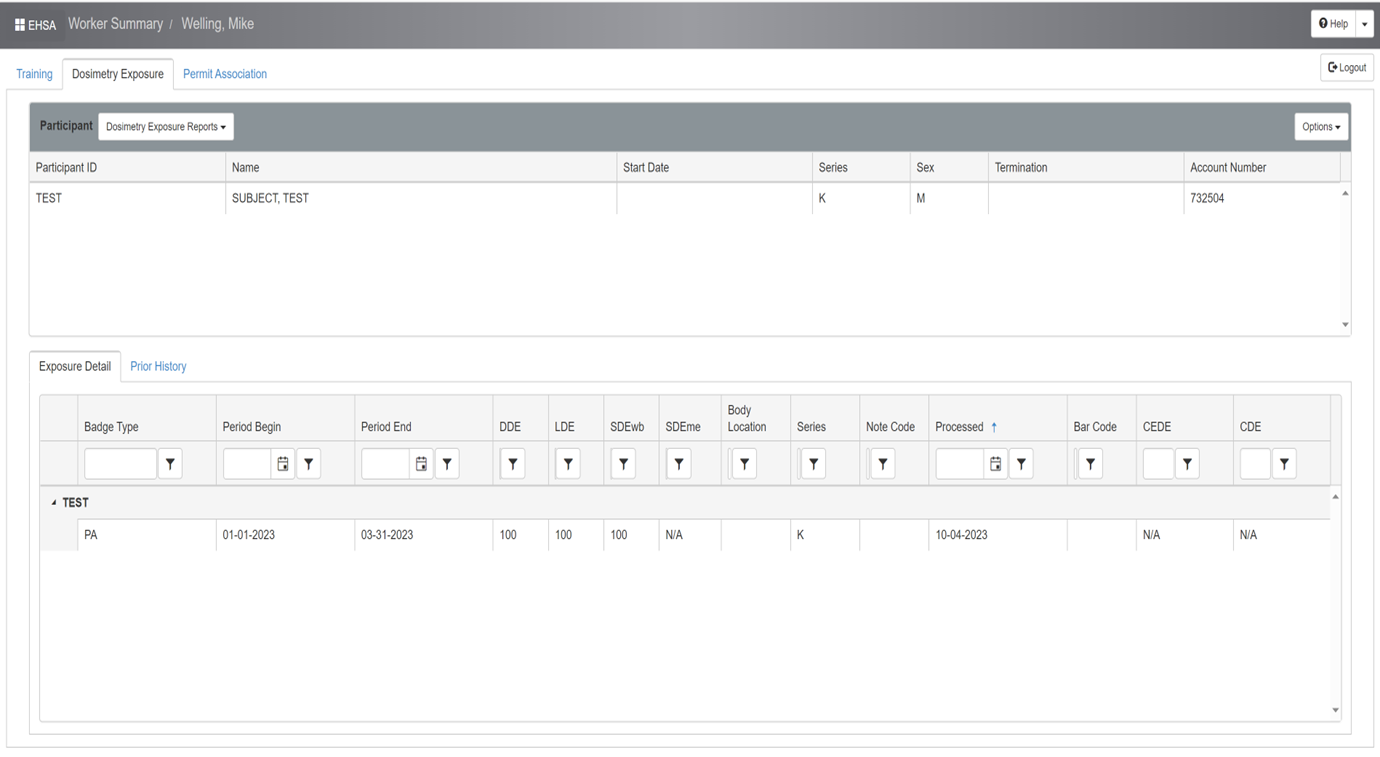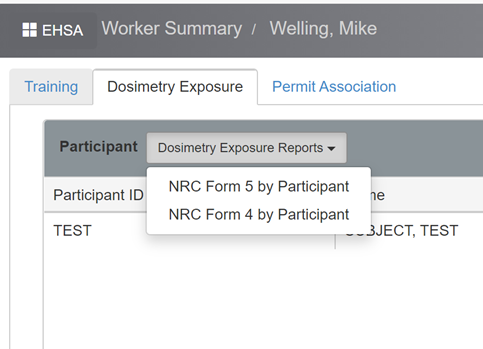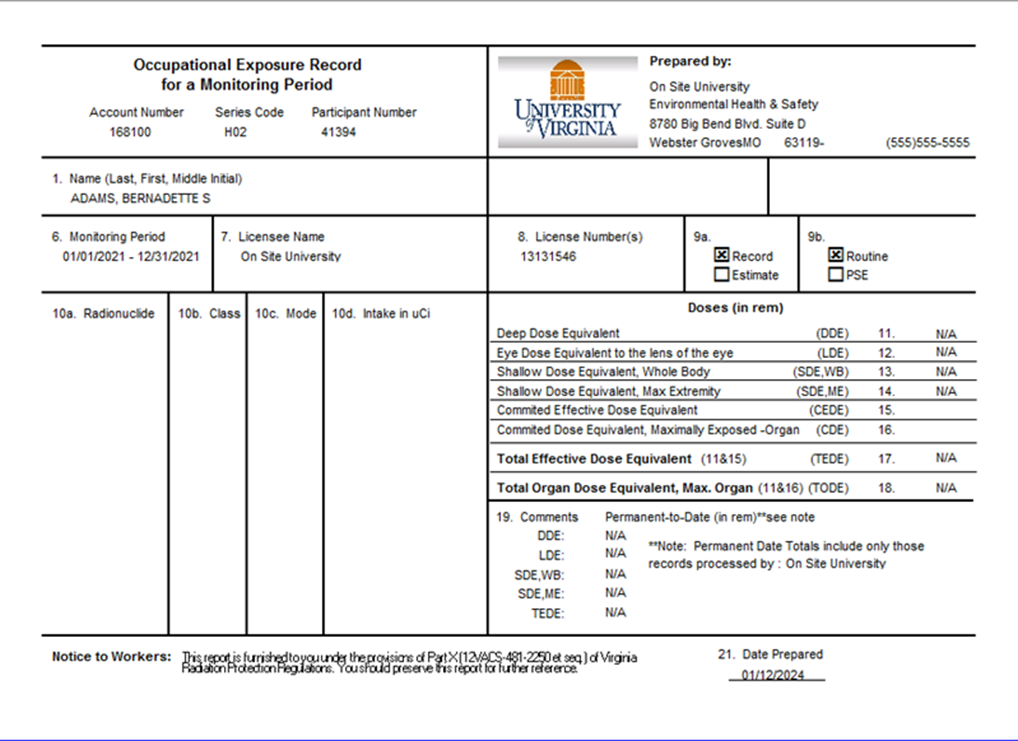
Dosimeters are used to monitor your occupational dose from radioactive material or radiation-producing equipment. VDH regulations require UVA to provide dosimetry to individuals likely to receive a radiation dose in excess of 500 mrem in one year and that certain individuals wear lead protection aprons to reduce this exposure.
UVA Policy SEC-009: Radiation Safety Program states the following with regards to dosimetry:
Personal Monitoring and Radiation Dosimetry:
Each supervisor/manager must identify those individuals in their respective areas who will be exposed to ionizing radiation, ensure they contact the EHS-Radiation Safety Program to obtain a dosimeter, and use proper dosimetry.
The University, through the EHS-Radiation Safety Program, shall provide radiation dosimeters to individuals who work with or around ionizing radiation after the individual completes the required radiation safety training and submits the appropriate application.
A radiation dosimeter shall be obtained and worn by individuals:
Workers who declare their pregnancy are governed under UVA Policy SEC-010: Radiation Worker Protection during Pregnancy.
Individuals whose radiation exposures exceed predefined levels as per the Radiation Safety Program and the RAM license application shall be notified and counseled on ALARA methods specific to their work environment to reduce radiation exposure.
Radiation exposures to individuals who are issued dosimetry will be reviewed by EHS-Radiation Safety Program staff. Personnel whose doses exceed predefined levels are presented to the RSC for review who may recommend actions to be taken. Personnel exposures exceeding regulatory limits must be reported to the Virginia Department of Health. The RSO and/or Registrant is responsible for reporting such events to the RSC and submitting written reports to the Virginia Department of Health in a timely manner.
Before a dosimeter can be issued, the applicant MUST:
If you have completed radiation safety training at another institution and have documentation of such, you do not need to complete either of the above-mentioned Radiation Safety Training Modules. Please document the course name and date of completion on the dosimeter application.
Dosimeters need to be worn on the torso facing outward. These dosimeters allow for determining if the dose was received at one time or over a period of time and what direction it was received from. This can only be done if you properly wear them.
VIEW OUR VIDEO: Proper Method for Wearing a Dosimeter. This video demonstrates the proper method for installing your issued dosimeter into the plastic holder clip and wearing the dosimeter on your body.
Here is how it should be worn while wearing lead aprons:

Finally, it is important to return your dosimeter each month or quarter for timely processing by Landauer. Dosimetry needs to be returned within 7 days of the wearing period. Radiation Safety Office staff will provide each department with their new dosimeters and then pick up the returned dosimeters. If you have additional questions, call the Dosimetry Program Coordinator at 434.982.4942.
For dosimeter wearers who become pregnant, by completing the Declaration of Pregnancy Form, it allows UVA to provide you with a fetal monitoring dosimeter. This dosimeter will monitor the exposure during your pregnancy and help UVA to "ensure that the dose equivalent to the embryo/fetus during the entire pregnancy, due to the occupational exposure of a declared pregnant woman, does not exceed 0.5 rem (5 mSv)".
UVA Policy SEC-010: Radiation Worker Protection during Pregnancy contains additional information.
Dosimeters for each UVA individual is given to the department dosimetry coordinator. You will receive your badge from this individual and will exchange your dosimeter with this individual at the required time. The Radiation Safety Office will be providing these individuals will the dosimetry reports from Landauer. You may ask them for your reported exposure. The Radiation Safety Office will also be providing these individuals the annual exposure report (Form 5) and ask them to distribute to each badged individual in their department.
See "Academic" badge list here.
Beginning in 2024, we have begun loading the Landauer dosimeter information into our EHSA database. This will allow each individual issued a badge to access their dose information at any time and download the annual Form 5 themselves.
Use this link to access the EHSA database. You must be logged onto a UVA system with your computing ID..
If you would like to use your phone to access the EHSA database, use the QR Code shown below.

This is what the EHSA dosimetry database looks like when you log in:

Your dose information will be in chronological order. Your occupational radiation dose from external sources of radiation is summarized on the right side of the form under "Doses (in rem)." The most important values for you to look at are:
Per VDH regulation 12VAC5-481-2280: Notifications and reports to individuals UVA is required to provide employees the annual Form 5 which provides you with your annual occupational dose received. To access this report, select highlight your name by clicking on it:

Then, click on the drop down box [Dosimetry Exposure Reports] and choose the [NRC Form 5 by participant] report:

The following will appear:

Next, select the year for which you would like the report for and select [View Report]. Ensure your pop up blocker is disabled and the following will appear:

Regulatory annual occupational radiation dose limits are set at levels below which there are believed to be negligible health risks to workers. Limits for different body parts are set to different levels because organs in the body differ in their sensitivity to radiation.
| Type | Annual regulatory limit |
|---|---|
| Whole body (DDE) | 5 rem |
| Lens of the eye (LDE) | 15 rem |
| Skin (SDE,WB) | 50 rem |
| Extremities (SDE,ME) | 50 rem |
| Committed effective dose equivalent (CEDE) | 5 rem |
| Committed dose equivalent (CDE) for maximally exposed organ | 50 rem |
| Fetal dose | 0.5 rem (during entire pregnancy) |
| Lifetime cumulative dose | Not regulated |
| Source of exposure | Estimated annual dose (NCRP Report 160) |
|---|---|
| All sources of natural background radiation, combined | 0.311 rem |
| Inhalation of naturally occurring radon | 0.228 rem |
| Exposure to cosmic radiation | 0.033 rem |
| Living in a brick, concrete, or stone home | 0.021 rem |
| Consumer products | 0.013 rem |